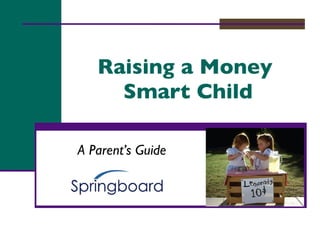Raising a Money Smart Child
•Download as PPT, PDF•
2 likes•854 views
A parent’s guide to providing children with the necessary basic financial skills as early as possible. It’s never too early to develop good saving and spending habits!
Report
Share
Report
Share

Recommended
5 Money-Draining Mistakes That Keep You Broke & Broken

5 Money-Draining Mistakes That Keep You Broke & BrokenBuilding Bridges Chicago LLC d/b/a Building Bridges Consulting
More Related Content
What's hot
5 Money-Draining Mistakes That Keep You Broke & Broken

5 Money-Draining Mistakes That Keep You Broke & BrokenBuilding Bridges Chicago LLC d/b/a Building Bridges Consulting
What's hot (20)
Money Management and Financial literacy for school students - Mumbai by Thoug...

Money Management and Financial literacy for school students - Mumbai by Thoug...
Financially Smart Parenting: It's more than just play dough

Financially Smart Parenting: It's more than just play dough
5 Money-Draining Mistakes That Keep You Broke & Broken

5 Money-Draining Mistakes That Keep You Broke & Broken
Similar to Raising a Money Smart Child
Similar to Raising a Money Smart Child (18)
Derin Dolen's Financial Planning Tips For a Lifetime

Derin Dolen's Financial Planning Tips For a Lifetime
Jeanne M. Hogarth - Build Your Financial Literacy Toolkit

Jeanne M. Hogarth - Build Your Financial Literacy Toolkit
Prepared your financial future with Stephen Cagnassola

Prepared your financial future with Stephen Cagnassola
More from Springboard
More from Springboard (11)
Glb privacy notice rev10 2012- student loan alliance

Glb privacy notice rev10 2012- student loan alliance
Budgeting_ Wise Use of Credit_Understanding Your Credit Report and Score

Budgeting_ Wise Use of Credit_Understanding Your Credit Report and Score
Identity Theft: Protecting & Restoring Your Good Name

Identity Theft: Protecting & Restoring Your Good Name
Recently uploaded
Mehran University Newsletter Vol-X, Issue-I, 2024

Mehran University Newsletter Vol-X, Issue-I, 2024Mehran University of Engineering & Technology, Jamshoro
TỔNG ÔN TẬP THI VÀO LỚP 10 MÔN TIẾNG ANH NĂM HỌC 2023 - 2024 CÓ ĐÁP ÁN (NGỮ Â...

TỔNG ÔN TẬP THI VÀO LỚP 10 MÔN TIẾNG ANH NĂM HỌC 2023 - 2024 CÓ ĐÁP ÁN (NGỮ Â...Nguyen Thanh Tu Collection
Recently uploaded (20)
ICT Role in 21st Century Education & its Challenges.pptx

ICT Role in 21st Century Education & its Challenges.pptx
This PowerPoint helps students to consider the concept of infinity.

This PowerPoint helps students to consider the concept of infinity.
Jual Obat Aborsi Hongkong ( Asli No.1 ) 085657271886 Obat Penggugur Kandungan...

Jual Obat Aborsi Hongkong ( Asli No.1 ) 085657271886 Obat Penggugur Kandungan...
Micro-Scholarship, What it is, How can it help me.pdf

Micro-Scholarship, What it is, How can it help me.pdf
On National Teacher Day, meet the 2024-25 Kenan Fellows

On National Teacher Day, meet the 2024-25 Kenan Fellows
Unit-IV; Professional Sales Representative (PSR).pptx

Unit-IV; Professional Sales Representative (PSR).pptx
ICT role in 21st century education and it's challenges.

ICT role in 21st century education and it's challenges.
Food safety_Challenges food safety laboratories_.pdf

Food safety_Challenges food safety laboratories_.pdf
Python Notes for mca i year students osmania university.docx

Python Notes for mca i year students osmania university.docx
TỔNG ÔN TẬP THI VÀO LỚP 10 MÔN TIẾNG ANH NĂM HỌC 2023 - 2024 CÓ ĐÁP ÁN (NGỮ Â...

TỔNG ÔN TẬP THI VÀO LỚP 10 MÔN TIẾNG ANH NĂM HỌC 2023 - 2024 CÓ ĐÁP ÁN (NGỮ Â...
Raising a Money Smart Child
- 1. Raising a Money Smart Child A Parent’s Guide
- 5. A child can have solid reading, writing, and math skills, but if they cannot manage their money, they will struggle, even fail as adults. You can change that. You can give them the basic framework to make good financial decisions. Armed with this knowledge, they will avoid financial trouble. You can change their lives. Introduction
- 6. “ Children and teenagers should begin learning basic financial skills as early as possible. Indeed, in many respects, improving basic financial education at the elementary and secondary school level is essential to providing a foundation for financial literacy that can help prevent younger people from making poor financial decisions that can take years to overcome." -Former Federal Reserve Chairman Alan Greenspan Introduction
- 19. My Goals